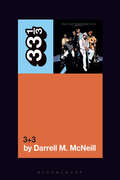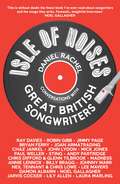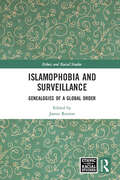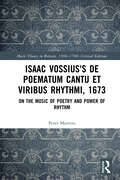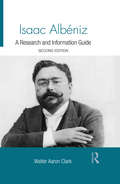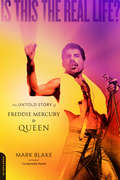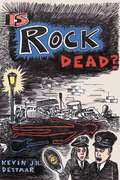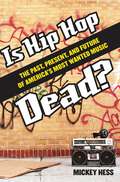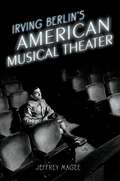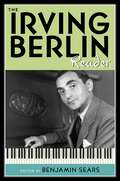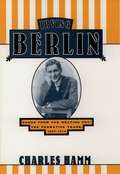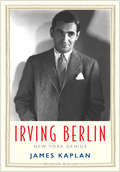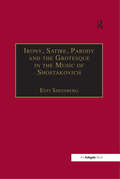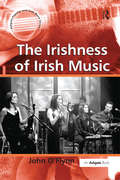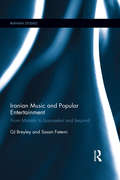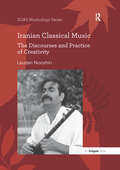- Table View
- List View
The Isley Brothers' 3+3 (33 1/3)
by Darrell M. McNeillThe Isley Brothers' 3+3, dissects The Isleys' 50-year-old undisputed masterwork, an album that firmly established their music dynasty on a global scale, as well as heralding the boldest run of genre-defiant albums of their 67-year career. The 1973 watershed was their first multiplatinum release and is significant as a rare, crossover record by a Black act that struck a chord with urban, rock, and pop consumers, despite the schisms between audiences due to bias-driven media and industry marketing.The book looks at the album from all angles: from The Isleys' early career to their influence on rock and rollers both Black and White, from the twists and turns of having national hits without national recognition, on to their decision to form T-Neck Records and the group's challenges navigating a music industry that racially codified music and hampered Black artists from universal acclaim and compensations. Finally, a summation of the decades follows The Isleys' run and its ups and downs, with a fast-forward to where the group is now after 67 years.
Isle of Noises: Conversations with great British songwriters
by Daniel RachelIsle of Noises features brand-new, exclusive, in-depth conversations with twenty-seven of the UK's greatest living musicians. Artists discuss their individual approach to writing, the inspiration behind their most successful songs, and the techniques and methods they have independently developed. It is an incredible musical journey spanning fifty years, from 'Waterloo Sunset' by Ray Davies to 'The Beast' by Laura Marling, with many lyrical and melodic secrets revealed along the way. Original handwritten lyrics from personal archives and notebooks (many never-before-seen) offer a unique glimpse into the heart of the creative process, and some of the greatest names in photography, including Jill Furmanovsky, Pennie Smith and Sheila Rock, have contributed stunning portraits of each artist. The combination of individual personal insights and the breadth and depth of knowledge in their collected experience makes Isle of Noises the essential word on classic British songwriting - as told by the songwriters themselves.
Islamophobia and Surveillance: Genealogies of a Global Order (Ethnic and Racial Studies)
by James RentonThe War on Terror has established a new global order of political structures, legislation, and technologies designed to spy on the world’s Muslims. This book explains the origins and trajectories of this political system. The contributors argue that a constellation of Western ideas about Muslims have evolved over time to produce an insatiable desire for all-pervasive, ever-expanding surveillance in our contemporary moment. The book posits that the surveillance order is not, however, only the result of conceptions of Muslims. It is, rather, the outcome of centuries of European thought regarding religion, governance, and revolution. Islamophobia and Surveillance traverses the existential desire for wakeful vigilance, the religious wars of early modern Europe, colonial India, the Balkan frontier of the EU, and the walls of the United States-Mexico border. The consequences of the new surveillance order transcend the West’s Muslim Question and threaten the very existence of the liberal democratic state. This book will, therefore, be of interest to those studying a range of subjects related to international co-operation, modern political systems, and security studies, as well as Islamophobia. Islamophobia and Surveillance was originally published as a special issue of Ethnic and Racial Studies.
Islamophobia and Surveillance: Genealogies of a Global Order (Ethnic and Racial Studies)
by James RentonThe War on Terror has established a new global order of political structures, legislation, and technologies designed to spy on the world’s Muslims. This book explains the origins and trajectories of this political system. The contributors argue that a constellation of Western ideas about Muslims have evolved over time to produce an insatiable desire for all-pervasive, ever-expanding surveillance in our contemporary moment. The book posits that the surveillance order is not, however, only the result of conceptions of Muslims. It is, rather, the outcome of centuries of European thought regarding religion, governance, and revolution. Islamophobia and Surveillance traverses the existential desire for wakeful vigilance, the religious wars of early modern Europe, colonial India, the Balkan frontier of the EU, and the walls of the United States-Mexico border. The consequences of the new surveillance order transcend the West’s Muslim Question and threaten the very existence of the liberal democratic state. This book will, therefore, be of interest to those studying a range of subjects related to international co-operation, modern political systems, and security studies, as well as Islamophobia. Islamophobia and Surveillance was originally published as a special issue of Ethnic and Racial Studies.
Isaac Vossius's De poematum cantu et viribus rhythmi, 1673: On the Music of Poetry and Power of Rhythm (Music Theory in Britain, 1500–1700: Critical Editions)
by Peter MartensDr Peter Martens provides the first complete edited English translation of, and commentary on, Issac Vossius’s De poematum cantu et viribus rythmi, a late seventeenth-century work of Continental musical humanism, all the more interesting for being published in England and dedicated to royalist Henry Bennett, Duke of Arlington. This treatise plays an important but poorly understood role in the continued development of rhythmopoeia; Vossius continues the arguments of figures such as Vincenzo Galilei and Marin Mersenne - desiring to link linguistic rhythm, music, and the passions - by proposing a practical, if undemonstrated, method for doing so based on ancient poetic feet. This resuscitation of poetic feet in the service of affect is made explicit by Vossius, but is undoubtedly more familiar to musicologists from Wolfgang Caspar Printz's 1696 Phrynis Mitilenaeus or Johann Mattheson's 1739 Der vollkommene Capellmeister. Vossius, or more correctly, De poematum cantu, was often cited during the century after its publication, and no modern treatment of rhythmopoeia seems complete without a citation or short excerpt from this work. There is little secondary literature that focuses on this treatise, but what does exist links this work directly to John Dryden's composition of his 1687 and 1697 St. Cecilia odes, and their musical settings by Giovanni Battista Draghi and Jeremiah Clarke, respectively. In Dean Mace and H. Neville Davies' debate over the extent of Vossius's influence on these works can be found a rich picture of the contentious issues surrounding text-setting and musical affect that so occupied a great many writers in late-seventeenth-century England. A full translation and accompanying discussion of Vossius's own sources and musical influences allows English-language students and scholars to access and study this work in the depth and to the degree it deserves.
Isaac Vossius's De poematum cantu et viribus rhythmi, 1673: On the Music of Poetry and Power of Rhythm (Music Theory in Britain, 1500–1700: Critical Editions)
by Peter MartensDr Peter Martens provides the first complete edited English translation of, and commentary on, Issac Vossius’s De poematum cantu et viribus rythmi, a late seventeenth-century work of Continental musical humanism, all the more interesting for being published in England and dedicated to royalist Henry Bennett, Duke of Arlington. This treatise plays an important but poorly understood role in the continued development of rhythmopoeia; Vossius continues the arguments of figures such as Vincenzo Galilei and Marin Mersenne - desiring to link linguistic rhythm, music, and the passions - by proposing a practical, if undemonstrated, method for doing so based on ancient poetic feet. This resuscitation of poetic feet in the service of affect is made explicit by Vossius, but is undoubtedly more familiar to musicologists from Wolfgang Caspar Printz's 1696 Phrynis Mitilenaeus or Johann Mattheson's 1739 Der vollkommene Capellmeister. Vossius, or more correctly, De poematum cantu, was often cited during the century after its publication, and no modern treatment of rhythmopoeia seems complete without a citation or short excerpt from this work. There is little secondary literature that focuses on this treatise, but what does exist links this work directly to John Dryden's composition of his 1687 and 1697 St. Cecilia odes, and their musical settings by Giovanni Battista Draghi and Jeremiah Clarke, respectively. In Dean Mace and H. Neville Davies' debate over the extent of Vossius's influence on these works can be found a rich picture of the contentious issues surrounding text-setting and musical affect that so occupied a great many writers in late-seventeenth-century England. A full translation and accompanying discussion of Vossius's own sources and musical influences allows English-language students and scholars to access and study this work in the depth and to the degree it deserves.
Isaac Albeniz: A Research and Information Guide (Routledge Music Bibliographies)
by Walter Aaron ClarkIsaac Albéniz is one of the most important figures in the history of Spanish music. A legendary child prodigy, he went on to become one of the leading concert pianists of his generation in Europe. However, he aspired to compose music rooted in the folklore of his native Spain, contributing seminal masterpieces that defined the sound of Spanish art music in the 20th century and served as an inspiration to his most eminent successors. This annotated bibliography and research guide provides an up-to-date and thorough presentation of all the sources any aficionado, performer, or scholar would need to deepen his or her understanding of this fascinating pianist and composer.
Isaac Albeniz: A Research and Information Guide (Routledge Music Bibliographies)
by Walter Aaron ClarkIsaac Albéniz is one of the most important figures in the history of Spanish music. A legendary child prodigy, he went on to become one of the leading concert pianists of his generation in Europe. However, he aspired to compose music rooted in the folklore of his native Spain, contributing seminal masterpieces that defined the sound of Spanish art music in the 20th century and served as an inspiration to his most eminent successors. This annotated bibliography and research guide provides an up-to-date and thorough presentation of all the sources any aficionado, performer, or scholar would need to deepen his or her understanding of this fascinating pianist and composer.
Is This the Real Life?: The Untold Story of Queen
by Mark BlakeThe definitive biography of Queen and Freddie Mercury, by the author of Comfortably Numb and Bring It On HomeDespite the death of their exuberant front man Freddie Mercury in 1991, Queen remains one of the most popular bands on the planet, with 300 million global album sales and the biopic Bohemian Rhapsody, a "foot-stomping celebration of Queen," hitting theaters. Yet the full story of their extraordinary success and the truths behind the enigmatic Mercury has never fully been told, until now.Journalist Mark Blake, author of the bestselling Pink Floyd biography Comfortably Numb, has drawn on his own earlier interviews with the band and conducted nearly 100 exclusive interviews with record producers, ex-band members, personal assistants, and school friends, including many of Freddie Mercury's earliest associates, to produce a complete, fascinating account of the band's rise from suburbia to worldwide super-stardom. Is This the Real Life? tells, for the first time, how this groundbreaking band became champions of the world.
Is Rock Dead?
by Kevin J.H. DettmarRock and roll's death has been forecast nearly since its birth; the country song "The Death of Rock and Roll" appeared in September 1956, showing that the music had already outraged a more conservative listening audience. Is Rock Dead? sets out to explore the varied and sometimes conflicting ways in which the death of rock has been discussed both within the discourse of popular music and American culture. If rock is dead, when did it die? Who killed it? Why do rock journalists lament its passing? Has its academic acceptance stabbed it in the back or resuscitated an otherwise lifeless corpse? Why is rock music the music that conservatives love to hate? On the other side of the coin, how have rock's biggest fans helped nail shut the coffin? Does rock feed on its own death-and-rebirth? Finally, what signs of life are there showing that rock, in fact, is surviving?Is Rock Dead? will appeal to all those who take seriously the notion that rock is a serious musical form. It will appeal to students of popular music and culture, and all those who have ever spun a 45, cranked up the radio, or strummed an air guitar.
Is Rock Dead?
by Kevin J.H. DettmarRock and roll's death has been forecast nearly since its birth; the country song "The Death of Rock and Roll" appeared in September 1956, showing that the music had already outraged a more conservative listening audience. Is Rock Dead? sets out to explore the varied and sometimes conflicting ways in which the death of rock has been discussed both within the discourse of popular music and American culture. If rock is dead, when did it die? Who killed it? Why do rock journalists lament its passing? Has its academic acceptance stabbed it in the back or resuscitated an otherwise lifeless corpse? Why is rock music the music that conservatives love to hate? On the other side of the coin, how have rock's biggest fans helped nail shut the coffin? Does rock feed on its own death-and-rebirth? Finally, what signs of life are there showing that rock, in fact, is surviving?Is Rock Dead? will appeal to all those who take seriously the notion that rock is a serious musical form. It will appeal to students of popular music and culture, and all those who have ever spun a 45, cranked up the radio, or strummed an air guitar.
Is Hip Hop Dead?: The Past, Present, and Future of America's Most Wanted Music
by Mickey HessHip hop is remarkably self-critical as a genre. In lyrics, rappers continue to debate the definition of hip hop and question where the line between underground artist and mainstream crossover is drawn, who owns the culture and who runs the industry, and most importantly, how to remain true to the culture's roots while also seeking fame and fortune. The tension between the desires to preserve hip hop's original culture and to create commercially successful music promotes a lyrical war of words between mainstream and underground artists that keeps hip hop very much alive today. In response to criticisms that hip hop has suffered or died in its transition to the mainstream, this book seeks to highlight and examine the ongoing dialogue among rap artists whose work describes their own careers.Proclamations of hip hop's death have flooded the airwaves. The issue may have reached its boiling point in Nas's 2006 album Hip Hop is Dead. Nas's album is driven by nostalgia for a mythically pure moment in hip hop's history, when the music was motivated by artistic passion, instead of base commercialism. In the course of this same album, however, Nas himself brags about making money for his particular record label. These and similar contradictions are emblematic of the complex forces underlying the dialogue that keeps hip hop a vital element of our culture. Is Hip Hop Dead? seeks to illuminate the origins of hip hop nostalgia and examine how artists maintain control of their music and culture in the face of corporate record companies, government censorship, and the standardization of the rap image.Many hip hop artists, both mainstream and underground, use their lyrics to engage in a complex dialogue about rhyme skills versus record sales, and commercialism versus culture. This ongoing dialogue invigorates hip hop and provides a common ground upon which we can reconsider many of the developments in the industry over the past 20 years. Building from black traditions that value knowledge gained from personal experience, rappers emphasize the importance of street knowledge and its role in forging a career in the music business. Lyrics adopt models of the self-made man narrative, yet reject the trajectories of white Americans like Benjamin Franklin who espoused values of prudence, diligence, and delayed gratification. Hip hop's narratives instead promote a more immediately viable gratification through crime and extend this criminal mentality to their work in the music business. Through the lens of hip hop, and the threats to hip hop culture, author Mickey Hess is able to confront a range of important issues, including race, class, criminality, authenticity, the media, and personal identity.
Irving Berlin's American Musical Theater (Broadway Legacies)
by Jeffrey MageeFrom patriotic "God Bless America" to wistful "White Christmas," Irving Berlin's songs have long accompanied Americans as they fall in love, go to war, and come home for the holidays. Irving Berlin's American Musical Theater is the first book to fully consider this songwriter's immeasurable influence on the American stage. Award-winning music historian Jeffrey Magee chronicles Berlin's legendary theatrical career, providing a rich background to some of the great composer's most enduring songs, from "There's No Business Like Show Business" to "Puttin' on the Ritz." Magee shows how Berlin's early experience singing for pennies made an impression on the young man, who kept hold of that sensibility throughout his career and transformed it into one of the defining attributes of Broadway shows. Magee also looks at darker aspects of Berlin's life, examining the anti-Semitism that Berlin faced and his struggle with depression. Informative, provocative, and full of colorful details, this book will delight song and theater aficionados alike as well as anyone interested in the story of a man whose life and work expressed so well the American dream.
Irving Berlin's American Musical Theater (Broadway Legacies)
by Jeffrey MageeFrom patriotic "God Bless America" to wistful "White Christmas," Irving Berlin's songs have long accompanied Americans as they fall in love, go to war, and come home for the holidays. Irving Berlin's American Musical Theater is the first book to fully consider this songwriter's immeasurable influence on the American stage. Award-winning music historian Jeffrey Magee chronicles Berlin's legendary theatrical career, providing a rich background to some of the great composer's most enduring songs, from "There's No Business Like Show Business" to "Puttin' on the Ritz." Magee shows how Berlin's early experience singing for pennies made an impression on the young man, who kept hold of that sensibility throughout his career and transformed it into one of the defining attributes of Broadway shows. Magee also looks at darker aspects of Berlin's life, examining the anti-Semitism that Berlin faced and his struggle with depression. Informative, provocative, and full of colorful details, this book will delight song and theater aficionados alike as well as anyone interested in the story of a man whose life and work expressed so well the American dream.
The Irving Berlin Reader (Readers on American Musicians)
by Benjamin SearsWithout any formal training in music composition, Irving Berlin took a knack for music and turned it into the most successful songwriting career in American history. Berlin was the first Tin Pan Alley songwriter to go uptown to Broadway with a complete musical score (Watch Your Step in 1914); he is the only songwriter to build a theater exclusively for his own work (The Music Box); and his name appears above the title of his Broadway shows and Hollywood films (Irving Berlin's Holiday Inn), still a rare honor for songwriters. Berlin is also notable due the length of his career in American Song; he sold his first song at the age of 18 and passed away at the age of 101 having outlived several of his own copyrights. Throughout his career, Berlin showed that a popular song need not be of a lesser quality than songs informed by the principles of "classical" music composition. Forty years after his last published song many of his songs remain popular and several have even entered folk song status, something no other 20th-century American songwriter can claim. As one of the most seminal figures of twentieth century, both in the world of music and in American culture more generally, and as one of the rare songwriters equally successful with popular songs, Broadway shows, and Hollywood scores, Irving Berlin is the subject of an enormous corpus of writing, scattered throughout countless publications and archives. A noted performer and interpreter of Berlin's works, Benjamin Sears has unprecedented familiarity with these sources and brings together in this Reader a broad range of the most insightful primary and secondary materials. Grouped together according to the chronology of Berlin's life and work, each section and article features a critical introduction to orient the reader and contextualize the materials within the framework of American musical history. Taken as a whole, the writings - many by Berlin himself -- provide a new perspective on Berlin that highlights his musical genius in the context of his artistic development.
Irving Berlin: Songs from the Melting Pot: The Formative Years, 1907-1914
by Charles HammIrving Berlin remains a central figure in American music, a lyricist/composer whose songs are loved all over the world. His first piece, "Marie from Sunny Italy," was written in 1907, and his "Alexander's Ragtime Band" attracted more public and media attention than any other song of its decade. In later years Berlin wrote such classics as "God Bless America," "Blue Skies," "Always," "Cheek to Cheek," and the holiday favorites "White Christmas" and "Easter Parade." Jerome Kern, his fellow songwriter, commented that "Irving Berlin is American music." In Irving Berlin: The Formative Years, Charles Hamm traces the early years of this most famous and distinctive American songwriter. Beginning with Berlin's immigrant roots--he came to New York in 1893 from Russia--Hamm shows how the young Berlin quickly revealed the talent for music and lyrics that was to mark his entire career. Berlin first wrote for the vaudeville stage, turning out songs that drew on the various ethnic cultures of the city. These pieces, with their Jewish, Italian, German, Irish, and Black protagonists singing in appropriate dialects, reflected the urban mix of New York's melting pot. Berlin drew on various musical styles, especially ragtime, for such songs as "Alexander's Ragtime Band," and Hamm devotes an entire chapter to the song and its success. The book also details Berlin's early efforts to write for the Broadway musical stage, culminating in 1914 with his first musical comedy, Watch Your Step, featuring the popular dance team, Vernon and Irene Castle. A great hit on Broadway and in London, the show was a key piece in the Americanization of the musical comedy. Blessed with prodigious ambition and energy, Berlin wrote at least 4 or 5 new songs a week, many of which were discarded. He nevertheless published 190 songs between 1907 and 1914, an astonishing number considering that when Berlin arrived in America, he knew not a single word of English. As one writer reported, "there is scarcely a waking moment when Berlin is not engaged either in teaching his songs to a vaudeville player, or composing new ones." Early in his career, Irving Berlin brilliantly exploited the musical trends and influences of the day. Hamm shows how Berlin emerged from the vital and complex social and cultural scene of New York to begin his rise as America's foremost songwriter.
Irving Berlin: New York Genius (Jewish Lives)
by James KaplanFrom the prizewinning Jewish Lives series, a fast†‘moving, musically astute portrait of arguably the greatest composer of American popular music Irving Berlin (1888–1989) has been called—by George Gershwin, among others—the greatest songwriter of the golden age of the American popular song. “Berlin has no place in American music,” legendary composer Jerome Kern wrote; “he is American music.” In a career that spanned an astonishing nine decades, Berlin wrote some fifteen hundred tunes, including “Alexander’s Ragtime Band,” “God Bless America,” and “White Christmas.” From ragtime to the rock era, Berlin’s work has endured in the very fiber of American national identity. Exploring the interplay of Berlin’s life with the life of New York City, noted biographer James Kaplan offers a visceral narrative of Berlin as self†‘made man and witty, wily, tough Jewish immigrant. This fast†‘paced, musically opinionated biography uncovers Berlin’s unique brilliance as a composer of music and lyrics. Masterfully written and psychologically penetrating, Kaplan’s book underscores Berlin’s continued relevance in American popular culture.About Jewish Lives: Jewish Lives is a prizewinning series of interpretative biography designed to explore the many facets of Jewish identity. Individual volumes illuminate the imprint of Jewish figures upon literature, religion, philosophy, politics, cultural and economic life, and the arts and sciences. Subjects are paired with authors to elicit lively, deeply informed books that explore the range and depth of the Jewish experience from antiquity to the present. In 2014, the Jewish Book Council named Jewish Lives the winner of its Jewish Book of the Year Award, the first series ever to receive this award.More praise for Jewish Lives: “Excellent.” – New York times “Exemplary.” – Wall St. Journal “Distinguished.” – New Yorker “Superb.” – The Guardian
Irony, Satire, Parody and the Grotesque in the Music of Shostakovich: A Theory of Musical Incongruities
by Esti SheinbergThe music of Shostakovich has been at the centre of interest of both the general public and dedicated scholars throughout the last twenty years. Most of the relevant literature, however, is of a biographical nature. The focus of this book is musical irony. It offers new methodologies for the semiotic analysis of music, and inspects the ironical messages in Shostakovich‘s music independently of political and biographical bias. Its approach to music is interdisciplinary, comparing musical devices with the artistic principles and literary analyses of satire, irony, parody and the grotesque. Each one of these is firstly inspected and defined as a separate subject, independent of music. The results of these inspections are subsequently applied to music, firstly music in general and then more specifically to the music of Shostakovich. The composer‘s cultural and historical milieux are taken into account and, where relevant, inspected and analysed separately before their application to the music.
Irony, Satire, Parody and the Grotesque in the Music of Shostakovich: A Theory of Musical Incongruities
by Esti SheinbergThe music of Shostakovich has been at the centre of interest of both the general public and dedicated scholars throughout the last twenty years. Most of the relevant literature, however, is of a biographical nature. The focus of this book is musical irony. It offers new methodologies for the semiotic analysis of music, and inspects the ironical messages in Shostakovich‘s music independently of political and biographical bias. Its approach to music is interdisciplinary, comparing musical devices with the artistic principles and literary analyses of satire, irony, parody and the grotesque. Each one of these is firstly inspected and defined as a separate subject, independent of music. The results of these inspections are subsequently applied to music, firstly music in general and then more specifically to the music of Shostakovich. The composer‘s cultural and historical milieux are taken into account and, where relevant, inspected and analysed separately before their application to the music.
The Irishness of Irish Music
by John O'FlynnThis book brings together important material from a range of sources and highlights how government organizations, musicians, academics and commercial companies are concerned with, and seek to use, a particular notion of Irish musical identity. Rooting the study in the context of the recent history of popular, traditional and classical music in Ireland, as well as providing an overview of aspects of the national field of music production and consumption, O'Flynn goes on to argue that the relationship between Irish identity and Irish music emerges as a contested site of meaning. His analysis exposes the negotiation and articulation of civic, ethnic and economic ideas within a shifting hegemony of national musical culture, and finds inconsistencies between and among symbolic constructions of Irish music and observed patterns in the domestic field. More specifically, O'Flynn illustrates how settings, genres, social groups and values can influence individual identifications or negations of Irishness in music. While the apprehension of intra-musical elements leads to perceptions of music that sounds Irish, style and authenticity emerge as critical articulatory principles in the identification of music that feels Irish. The celebratory and homogenizing discourse associated with the international success of some Irish musical forms is not reflected in the opinions of the people interviewed by O'Flynn; at the same time, an insider/outsider dialectic of national identity is found in various forms of discourse about Irish music. Performers and composers discussed include Bill Whelan (Riverdance), Sinead O'Connor, The Corrs, Altan, U2, Martin Hayes, Dolores Keane and Gerald Barry.
The Irishness of Irish Music
by John O'FlynnThis book brings together important material from a range of sources and highlights how government organizations, musicians, academics and commercial companies are concerned with, and seek to use, a particular notion of Irish musical identity. Rooting the study in the context of the recent history of popular, traditional and classical music in Ireland, as well as providing an overview of aspects of the national field of music production and consumption, O'Flynn goes on to argue that the relationship between Irish identity and Irish music emerges as a contested site of meaning. His analysis exposes the negotiation and articulation of civic, ethnic and economic ideas within a shifting hegemony of national musical culture, and finds inconsistencies between and among symbolic constructions of Irish music and observed patterns in the domestic field. More specifically, O'Flynn illustrates how settings, genres, social groups and values can influence individual identifications or negations of Irishness in music. While the apprehension of intra-musical elements leads to perceptions of music that sounds Irish, style and authenticity emerge as critical articulatory principles in the identification of music that feels Irish. The celebratory and homogenizing discourse associated with the international success of some Irish musical forms is not reflected in the opinions of the people interviewed by O'Flynn; at the same time, an insider/outsider dialectic of national identity is found in various forms of discourse about Irish music. Performers and composers discussed include Bill Whelan (Riverdance), Sinead O'Connor, The Corrs, Altan, U2, Martin Hayes, Dolores Keane and Gerald Barry.
Iranian Music and Popular Entertainment: From Motrebi to Losanjelesi and Beyond (Iranian Studies)
by Sasan Fatemi GJ BreyleyThe word motreb finds its roots in the Arabic verb taraba, meaning ‘to make happy.’ Originally denoting all musicians in Iran, motrebi came to be associated, pejoratively, with the cheerful vulgarity of the lowbrow entertainer. In Iranian Music and Popular Entertainment, GJ Breyley and Sasan Fatemi examine the historically overlooked motrebi milieu, with its marginalized characters, from luti to gardan koloft and mashti, as well as the tenacity of motreb who continued their careers against all odds. They then turn to losanjelesi, the most pervasive form of Iranian popular music that developed as motrebi declined, and related musical forms in Iran and its diasporic popular cultural centre, Los Angeles. For the first time in English, the book makes available musical transcriptions, analysis and lyrics that illustrate the complexities of this history. As it presents the findings of the authors’ years of ethnographic work with the history’s protagonists, from senior motreb to pop-rock stars, the book reveals parallels between the decline of motrebi and the rise of ‘modernity.’ In the twentieth century, the fate of Tehran’s motrebi music was shaped by the social and urban polarization that ensued from the modern market economy, and losanjelesi would be similarly affected by transnational relations, revolution, war and migration. Through its detailed and informed examination of Iranian popular music, this study reveals much about the values and anxieties of Iranian society, and is a valuable resource for students and scholars of Iranian society and history.
Iranian Music and Popular Entertainment: From Motrebi to Losanjelesi and Beyond (Iranian Studies)
by Sasan Fatemi GJ BreyleyThe word motreb finds its roots in the Arabic verb taraba, meaning ‘to make happy.’ Originally denoting all musicians in Iran, motrebi came to be associated, pejoratively, with the cheerful vulgarity of the lowbrow entertainer. In Iranian Music and Popular Entertainment, GJ Breyley and Sasan Fatemi examine the historically overlooked motrebi milieu, with its marginalized characters, from luti to gardan koloft and mashti, as well as the tenacity of motreb who continued their careers against all odds. They then turn to losanjelesi, the most pervasive form of Iranian popular music that developed as motrebi declined, and related musical forms in Iran and its diasporic popular cultural centre, Los Angeles. For the first time in English, the book makes available musical transcriptions, analysis and lyrics that illustrate the complexities of this history. As it presents the findings of the authors’ years of ethnographic work with the history’s protagonists, from senior motreb to pop-rock stars, the book reveals parallels between the decline of motrebi and the rise of ‘modernity.’ In the twentieth century, the fate of Tehran’s motrebi music was shaped by the social and urban polarization that ensued from the modern market economy, and losanjelesi would be similarly affected by transnational relations, revolution, war and migration. Through its detailed and informed examination of Iranian popular music, this study reveals much about the values and anxieties of Iranian society, and is a valuable resource for students and scholars of Iranian society and history.
Iranian Classical Music: The Discourses and Practice of Creativity (SOAS Studies in Music Series)
by Laudan NooshinQuestions of creativity, and particularly the processes which underlie creative performance or ’improvisation’, form some of the central areas of interest in current musicology. Yet the predominant discourses on which musicological thought in this area are based have rarely been challenged. In this book Laudan Nooshin interrogates musicological discourses of creativity from the perspective of critical theory and postcolonial studies, examining their ideological underpinnings, the relationships of alterity which they sustain, and the profound implications for our understanding of creative processes in music. The repertoire which forms the book’s main focus is Iranian classical music, a tradition in which the performer plays a central creative role. Addressing a number of issues regarding the nature of musical creativity, the author explores both the discourses through which ideas about creativity are constructed, exchanged and negotiated within this tradition, and the practice by which new music comes into being. For the latter she compares a number of performances by musicians playing a range of instruments and spanning a period of more than 30 years, focusing on one particular section of repertoire, dastgāh Segāh, and providing transcriptions of the performances as the basis for analytical exploration of the music’s underlying compositional principles. This book is about understanding musical creativity as a meaningful social practice. It is the first to examine the ways in which ideas about tradition, authenticity, innovation and modernity in Iranian classical music form part of a wider social discourse on creativity, and in particular how they inform debates regarding national and cultural identity.
Iranian Classical Music: The Discourses and Practice of Creativity (SOAS Studies in Music Series)
by Laudan NooshinQuestions of creativity, and particularly the processes which underlie creative performance or ’improvisation’, form some of the central areas of interest in current musicology. Yet the predominant discourses on which musicological thought in this area are based have rarely been challenged. In this book Laudan Nooshin interrogates musicological discourses of creativity from the perspective of critical theory and postcolonial studies, examining their ideological underpinnings, the relationships of alterity which they sustain, and the profound implications for our understanding of creative processes in music. The repertoire which forms the book’s main focus is Iranian classical music, a tradition in which the performer plays a central creative role. Addressing a number of issues regarding the nature of musical creativity, the author explores both the discourses through which ideas about creativity are constructed, exchanged and negotiated within this tradition, and the practice by which new music comes into being. For the latter she compares a number of performances by musicians playing a range of instruments and spanning a period of more than 30 years, focusing on one particular section of repertoire, dastgāh Segāh, and providing transcriptions of the performances as the basis for analytical exploration of the music’s underlying compositional principles. This book is about understanding musical creativity as a meaningful social practice. It is the first to examine the ways in which ideas about tradition, authenticity, innovation and modernity in Iranian classical music form part of a wider social discourse on creativity, and in particular how they inform debates regarding national and cultural identity.
